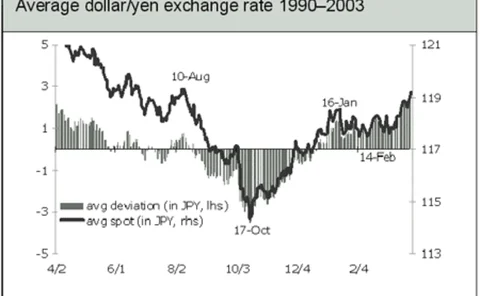Market voice
The year ahead in Asia
US dollar weakness and regional equity market strength look set to remain the main drivers of Asian FX in 2004, according to Tim Condon, chief economist, Asia for ING Financial Markets in Hong Kong
The ghost of Bentsen
The lessons of history may help in assessing the dollar’s fortunes in 2004, says Peter Luxton, economic adviser at Informa Global Markets in London
More dollar pain before H2 rebound
The dollar will suffer much more pain in the near term before rebounding in the second half of 2004, says Larry Kantor, global head of economics and market strategy at Barclays Capital in New York
Dollar crisis? Think again
The US current account deficits are sustainable, and the dollar correction has largely come and gone, says Frank Gong, chief FX strategist at Bank of America in Hong Kong
Aussie dollar nears its cyclical peak
The Australian dollar’s rally is almost over and investors should look to take profits or reduce long positions in the coming months, says Karen Pringle, senior currency strategist at ANZ Investment Bank in London.
Euro/yen to trend lower
Eurozone competitiveness versus the yen has fallen sharply since a peak in 2001, and the current level of euro/yen is likely to fall again by mid-2004, says Steven Saywell (right), director of currency strategy at Citigroup in London
E-dealing requires better pricing
Efficiency gains available from technology are being undermined by pricing discrepancies, says Cognotec chairman Brian Maccaba.
A strengthening yen is no barrier to Japan's exporters
A stronger yen isn't proving to be the disaster for Japanese exporters that many predicted. Tohru Sasaki, chief FX strategist at JP Morgan Chase Bank in Tokyo, looks at why a strengthening Japanese currency doesn't necessarily mean decreasing revenues…
Managing sterling risks
Trading cable or euro/sterling off fundamentals is fraught with risk because they are primarily driven by trends in euro/dollar, says Steven Englander, Barclays Capital’s New York-based chief FX strategist for the Americas. But a properly constructed…
US abandons strong dollar policy -- but will Asia?
The G-7 communiqué at the IMF/World Bank annual meetings in Dubai marked the end of the US administration’s ‘strong dollar’ policy. But does it also signal a change in Asia’s preference for a strong dollar?
Seasonal yen patterns
Dollar/yen’s statistically significant seasonal pattern bottoms in mid-October and rises through mid-January. Greg Anderson, senior FX strategist at ABN Amro in Chicago, recommends looking for a spike in the flat period to come and selling into it
Changing fortunes
September’s G-7 communiqué was a departure from its usual bland messages, and Asian currencies have reacted accordingly. Jimmy Koh (right), head of economics treasury research at United Overseas Bank in Singapore, explores some of the likely future…
Dollar weakness to continue into 2004
Dollar weakness can be expected for many months to come and could continue even longer than first anticipated, says Michael Rosenberg, global head of FX research at Deutsche Bank in New York
MoF/BoJ re-enter FX market
The continuing weak economy and the growth differential between the US and Japan will become more pronounced over the course of this month, allowing the dollar/yen to regain the 115 level, say FX strategists Lauren Germain (right) and Uwe Parpart at Bank…
The post-G7 environment
The latest G7 communiqué seems dramatic compared with recent years, but it is logical and consistent over the longer term, says Simon Derrick (right), head of currency research at the Bank of New York in London
Asian currencies set to outperform
Asia is heading for a period of sustained growth. And with high US budget and current account deficits, the region is likely to replace the US for leading global economic growth, says Hans Redeker, global head of currency strategy at BNP Paribas in London
Aussie’s halcyon days are not over
The Australian dollar’s strong rise in the first half of the year may have fallen off, but that does not mean its best performance is behind it, says Michael Jansen, market strategist at National Australia Bank in Sydney
Changing seasons
Summer volatility in a number of emerging markets is not unusual. Indeed, in the currencies of central and eastern Europe (CEE) it is the rule rather than the exception, says Callum Henderson, head of emerging markets research at Bank of America (BoA) in…
Asian central banks favour liberalisation
Recent developments suggest a move towards liberalisation rather than revaluation in Asian currencies, says David Mann (right) economist at Standard Chartered Bank in London
The euro: a relief valve for imbalance
As the dollar's decline is set to continue, the euro bears the brunt of the global trade imbalance, says Michael Woolfolk, senior currency strategist at Bank of New York in New York
Time to sell dollars with bonds
With global demand for savings rising, minimal growth in the savings pool, and shifts in notions of sovereign risk for debtor countries such as the US, it is time to sell dollars, says David Gilmore, partner at FX Analytics in Essex, Connecticut
Dollar decline likely to be over for now
Strong US data and stock market resilience point to a halt in the dollar’s decline, says Jesper Dannesboe, chief FX strategist at Dresdner Kleinwort Wasserstein in London
Candollar cartwheels
The Bank of Canada’s unexpected rate cut caused the Canadian dollar to do an about face after strengthening 13% against the US dollar in the year to date. But we can still expect Candollar strength later this year, says Lara Rhame, FX economist at Brown…
Asset sales support baht and rupiah
A wave of asset sales and privatisation in Indonesia and Thailand looks set to strengthen the Indonesian rupiah and Thai baht, says Irene Cheung (right), Asian sovereign and FX strategist at ABN Amro in Singapore
